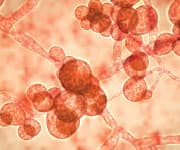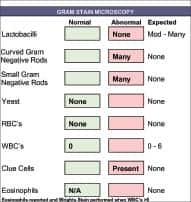Life Extension Magazine®
Vaginitis or vaginal inflammation includes symptoms such as vaginal discomfort, itching, and discolored, malodorous discharge.

The most common causes are yeast infections and bacterial vaginosis (BV), an overgrowth of harmful bacteria. These causes can be difficult to
Life Extension® now offers an at-home Vaginosis Profile test. In this interview, Dr. Shanti Albani explains how it can help women and their doctors determine the cause of their vaginal symptoms and identify treatment options.
LE: When would women need to use the Vaginosis Profile?

Dr. Albani: This test is meant for women who are experiencing vaginal discomfort or discharge. It can identify bacterial and yeast imbalances in their vaginal flora (the microorganisms that live in the vagina). That can help distinguish between a yeast infection and bacterial vaginosis.
LE: How is that helpful?
Dr. Albani: By profiling the vaginal flora, the Vaginosis Profile helps women and their practitioners identify vaginal microbiota problems. Then they can use a targeted approach to restore microflora harmony. It also identifies which treatments, either natural or pharmaceutical, are most likely to be effective. This is especially helpful for chronic and reoccurring vaginal infections, where organism resistance to prescriptive or natural agents causes persistent issues.
LE: Aren’t most vaginal infections caused by yeast? If so, is there really a need for testing?

Dr. Albani: Contrary to widespread belief, the most common cause of vaginal symptoms is not yeast. It is bacterial vaginosis. Over-the-counter yeast treatments,such as Monistat®, will only be effective against yeast, not bacterial vaginosis.
LE: That’s surprising. Can you tell us more about the differences between yeast infections and bacterial vaginosis?
Dr. Albani: The most frequently implicated organism in vaginal yeast infections is Candida albicans, though other yeast species can be responsible. Bacterial vaginosis, on the other hand, occurs when anaerobic bacteria such as Gardnerella vaginalis, Mycoplasma hominis, or Prevotella increase and overcome the natural predominance of Lactobacillus bacteria. Included in this test is a yeast and bacterial culture, it can identify which species of yeast or bacteria may be causing symptoms. There are some symptoms that may correlate with a yeast versus bacterial vaginal infection, but the symptoms are not cut-and-dry. This test can help clarify and prevent misdiagnosis.

LE: After testing, is it simply a matter of discussing treatments with a physician?
Dr. Albani: Importantly, both bacterial vaginosis and yeast infections can develop resistance to antibiotic and antifungal medications. For this reason, the Vaginosis Profile includes sensitivity testing. This identifies the prescriptive and natural substances to which cultured microorganisms are susceptible or resistant. This takes much of the guesswork out of effective treatment, allowing a woman and her practitioner to target their approach.
LE: What else is included in the test?

Dr. Albani: Vaginal specimens are also carefully examined under the microscope for yeast, gram-negative bacteria, lactobacilli, red and white blood cells, eosinophils, and “clue cells.” Clue cells are cells from the vagina that look fuzzy under the microscope. They take on this fuzzy appearance because they are coated with bacteria and their presence is one of the most specific confirmations of bacterial vaginosis. The degree to which white blood cells are present helps evaluate the level of vaginal inflammation. Combined with the culture and sensitivity, the microscopic evaluation enhances the ability of the Vaginosis Profile to distinguish between bacterial vaginosis and yeast.
LE: How is the sample collected?

Dr. Albani: The test is an easy-to-use kit, allowing for self-collection in the comfort of your home. It includes a vaginal swab, which you use to gently collect a sample by rotating it for 15-30 seconds against the sides of the vagina. There’s a collection tube into which the swab is placed for delivery to the lab. Once the collection is complete, it is sent to the lab using a provided pre-paid shipping label.
LE: Are there causes of vaginal discomfort that are not identified by the Vaginosis Profile?

Dr. Albani: The test differentiates between the two most common causes of vaginal symptoms, bacterial vaginosis and yeast infection, and looks at overall microflora imbalances. It can also indicate a possible allergic response if a specific type of white blood cell called eosinophils is elevated. However, it does not identify all causes of vaginitis. Some origins of vaginal discomfort not identified by the Vaginosis Profile include trauma, some skin conditions, and hormonal changes. This is also not a test for the sexually transmitted infections chlamydia, gonorrhea, or trichomonas. It is important that women discuss their symptoms and test results with their practitioners to ensure a more serious condition is not overlooked.
LE: What else would you like women to know about the Vaginosis Profile and restoring vaginal health?

Dr. Albani: Since small numbers of yeast and anaerobic bacteria are part of a healthy vaginal flora, identifying what allowed these organisms to overpopulate is as important as proper diagnosis and treatment. Several culprits have been identified, including poor diet, poor hygiene, antibiotic use, hormonal changes, tight or damp clothes, corticosteroids, sexual contact, douching, underlying health conditions, and use of chemical or scented hygiene products. Identifying underlying causes of flora imbalances allows women to make changes to optimize vaginal health and prevent reoccurrence.
LE: This sounds similar to a stool analysis test in the way it identifies problem microbes and flora imbalances. Is that accurate?
Dr. Albani: Yes. It is the same approach: testing for problematic microbes, assessing for microflora imbalances, and then using that detailed information to restore balance and harmony. This Vaginosis Profile uses the same advanced technology used in stool testing to provide critical information about a woman’s vaginal health. We now know that different areas of the body have differing microflora concentrations and that testing should be specific to the area in question. In the future you will see more body-specific areas of testing to assess microflora.
LE: Once someone has the test results, what are the next steps in using them to improve vaginal health?

Dr. Albani: All tests come with a detailed, written explanation of what the results may mean. That includes various treatment options. Customers can call in and speak with one of Life Extension’s specially trained Wellness Specialists, who can discuss the meaning of the test results and suggest wellness options. Women should always work with their doctors, as well, to ensure proper treatment.
If you have any questions on the scientific content of this article, please call a Life Extension® Wellness Specialist at 1-866-864-3027.
Dr. Shanti Albani earned her medical degree in Naturopathic Medicine in 2003 from the National University of Natural Medicine in Portland, Oregon. She practiced medicine for many years in central Mexico, specializing in gastrointestinal disorders and hormone balance. During this time she taught courses for physicians in bioidentical hormone replacement therapy. She has worked at Life Extension® since 2010 and is currently the Manager of Clinical Information.

